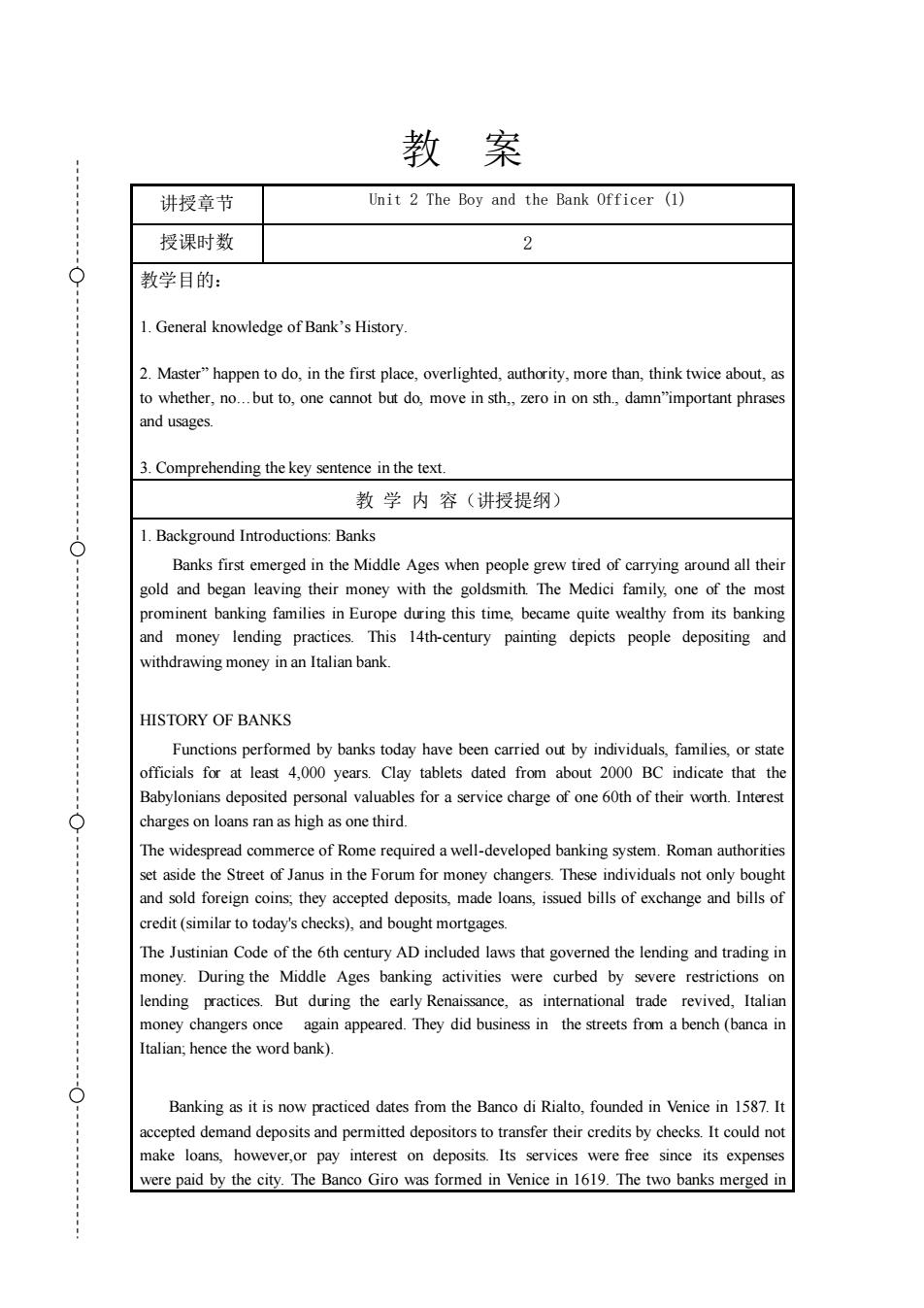正在加载图片...

教案 讲授章节 Unit 2 The Boy and the Bank officer (1) 授课时数 2 教学目的: 1.General knowledge of Bank's History 2.Master"happen to do,in the first place,overlighted,authority,more than,think twice about,as to whether,no.but to,one cannot but do,move in sth.,zero in on sth.damn"important phrases and usages. 3.Comprehending the key sentence in the text. 教学内容(讲授提纲) 1.Background Introductions:Banks Banks first emerged in the Middle Ages when people grew tired of carrying around all their gold and began leaving their money with the goldsmith.The Medici family,one of the most prominent banking families in Europe during this time,became quite wealthy from its banking and money lending practices This painting depicts pople depositing an withdrawing money in an Italian bank HISTORY OF BANKS Babylonians deposited personal valuables for a service charge of one 60th of their worth.Interest charges on loans ran as high as one third. The widespread commerce of Rome required a well-developed banking system.Roman authoritie set aside the Street of Janus in the Forum for money changers.These individuals not only bought and sold foreign coins,they accepted deposits,made loans,issued bills of exchange and bills of credit(similar to today's checks),and bought mortgages. The Justinian Code of the 6th century AD included laws that governed the lending and trading in money.During the Middle Ages banking activities were curbed by severe restrictions on lending practices.But during the early Renaissance.as international trade revived,Italian money changersonce again appeared.They did business in the streets from a bench(banca in hence the word bank). Banking as it is now practiced dates from the Banco di Rialto,founded in Venice in 1587.I accepted demand deposits and permitted depositors to transfer their credits by checks.It could not make loans,however,or pay interest on deposits.Its services were free since its expenses were paid by the city.The Banco Giro was formed in Venice in 1619.The two banks merged in教 案 讲授章节 Unit 2 The Boy and the Bank Officer (1) 授课时数 2 教学目的: 1. General knowledge of Bank’s History. 2. Master” happen to do, in the first place, overlighted, authority, more than, think twice about, as to whether, no.but to, one cannot but do, move in sth, zero in on sth., damn”important phrases and usages. 3. Comprehending the key sentence in the text. 教 学 内 容(讲授提纲) 1. Background Introductions: Banks Banks first emerged in the Middle Ages when people grew tired of carrying around all their gold and began leaving their money with the goldsmith. The Medici family, one of the most prominent banking families in Europe during this time, became quite wealthy from its banking and money lending practices. This 14th-century painting depicts people depositing and withdrawing money in an Italian bank. HISTORY OF BANKS Functions performed by banks today have been carried out by individuals, families, or state officials for at least 4,000 years. Clay tablets dated from about 2000 BC indicate that the Babylonians deposited personal valuables for a service charge of one 60th of their worth. Interest charges on loans ran as high as one third. The widespread commerce of Rome required a well-developed banking system. Roman authorities set aside the Street of Janus in the Forum for money changers. These individuals not only bought and sold foreign coins; they accepted deposits, made loans, issued bills of exchange and bills of credit (similar to today's checks), and bought mortgages. The Justinian Code of the 6th century AD included laws that governed the lending and trading in money. During the Middle Ages banking activities were curbed by severe restrictions on lending practices. But during the early Renaissance, as international trade revived, Italian money changers once again appeared. They did business in the streets from a bench (banca in Italian; hence the word bank). Banking as it is now practiced dates from the Banco di Rialto, founded in Venice in 1587. It accepted demand deposits and permitted depositors to transfer their credits by checks. It could not make loans, however,or pay interest on deposits. Its services were free since its expenses were paid by the city. The Banco Giro was formed in Venice in 1619. The two banks merged in